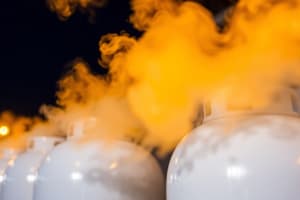Podcast
Questions and Answers
What is a primary feature of photoionization in odor control?
What is a primary feature of photoionization in odor control?
- Treatment of odors as a whole (correct)
- Dependency on chemical scrubbers
- Elimination of specific chemical substances
- Operation sensitivity to environmental conditions
Which of the following is NOT a requirement for photoionization operation?
Which of the following is NOT a requirement for photoionization operation?
- Nutrients (correct)
- Water (correct)
- Electricity
- Chemicals (correct)
What advantage does photoionization offer in terms of maintenance and operation?
What advantage does photoionization offer in terms of maintenance and operation?
- Very low maintenance and operation demand (correct)
- Monthly operational checks required
- High maintenance demand
- Frequent chemical replenishment necessary
Why is photoionization considered an effective technology for odor treatment?
Why is photoionization considered an effective technology for odor treatment?
Which characteristic enhances the scalability of photoionization systems?
Which characteristic enhances the scalability of photoionization systems?
What is one primary advantage of biological methods of odor treatment compared to physicochemical processes?
What is one primary advantage of biological methods of odor treatment compared to physicochemical processes?
What is the main operational cost related to biofilters?
What is the main operational cost related to biofilters?
What happens to odor-causing compounds in a biofilter as they pass through the organic media?
What happens to odor-causing compounds in a biofilter as they pass through the organic media?
Which component is NOT part of a typical biofilter's construction?
Which component is NOT part of a typical biofilter's construction?
What is the relationship between Empty Bed Residence Time (EBRT) and performance of biofilters?
What is the relationship between Empty Bed Residence Time (EBRT) and performance of biofilters?
How long is the required EBRT to effectively remove hydrogen sulfide (H2S) from air in a biofilter?
How long is the required EBRT to effectively remove hydrogen sulfide (H2S) from air in a biofilter?
Which of the following correctly states a function that biofilter microbes perform?
Which of the following correctly states a function that biofilter microbes perform?
What is a characteristic feature of biofilters that allows them to operate efficiently?
What is a characteristic feature of biofilters that allows them to operate efficiently?
What condition in wastewater treatment is primarily responsible for odor generation?
What condition in wastewater treatment is primarily responsible for odor generation?
Which of the following bacteria thrive in anaerobic conditions and produce hydrogen sulfide?
Which of the following bacteria thrive in anaerobic conditions and produce hydrogen sulfide?
What is a common byproduct of sulfate-reducing bacteria that is associated with a strong odor?
What is a common byproduct of sulfate-reducing bacteria that is associated with a strong odor?
In which area of a wastewater treatment facility are odor issues most prominent?
In which area of a wastewater treatment facility are odor issues most prominent?
Which compound is NOT typically associated with odor issues in biosolids treatment?
Which compound is NOT typically associated with odor issues in biosolids treatment?
What type of treatment method is a bioscrubber classified as?
What type of treatment method is a bioscrubber classified as?
What type of process is NOT used for odor removal according to the classification of treatment technologies?
What type of process is NOT used for odor removal according to the classification of treatment technologies?
What is a common characteristic of odor compounds released during biosolids dewatering?
What is a common characteristic of odor compounds released during biosolids dewatering?
What is the primary function of a biofilter?
What is the primary function of a biofilter?
What is the perception threshold in relation to odor units?
What is the perception threshold in relation to odor units?
Which type of biofilter media typically has a long life and lower loading rates?
Which type of biofilter media typically has a long life and lower loading rates?
What is a key consideration when designing a biofilter?
What is a key consideration when designing a biofilter?
Why is an acidic scrubber utilized in an NH3 scrubber system?
Why is an acidic scrubber utilized in an NH3 scrubber system?
What temperature range is considered optimal for effective odor elimination in biofilters?
What temperature range is considered optimal for effective odor elimination in biofilters?
What is one method of odor elimination mentioned in the content?
What is one method of odor elimination mentioned in the content?
Which characteristic best describes organic media used in biofilters?
Which characteristic best describes organic media used in biofilters?
Flashcards
Sulfate-reducing Bacteria
Sulfate-reducing Bacteria
A type of bacteria that thrives in low-oxygen environments and uses sulfate ions (SO4-) as an oxygen source for respiration, producing hydrogen sulfide (H2S) as a byproduct, which is responsible for the characteristic rotten-egg odor.
Anaerobic Decomposition
Anaerobic Decomposition
The process by which microorganisms break down organic matter in the absence of oxygen. It often results in the production of foul-smelling compounds, particularly hydrogen sulfide.
Hydrogen Sulfide (H2S)
Hydrogen Sulfide (H2S)
A gaseous compound with a distinctive rotten-egg odor. It is often produced during anaerobic decomposition and is a common cause of odor problems in wastewater treatment plants.
Activated Sludge Process
Activated Sludge Process
Signup and view all the flashcards
MSW Plant (Municipal Solid Waste Plant)
MSW Plant (Municipal Solid Waste Plant)
Signup and view all the flashcards
Biosolids Dewatering
Biosolids Dewatering
Signup and view all the flashcards
Biofiltration
Biofiltration
Signup and view all the flashcards
Scrubbing
Scrubbing
Signup and view all the flashcards
Biofilter
Biofilter
Signup and view all the flashcards
Empty Bed Residence Time (EBRT)
Empty Bed Residence Time (EBRT)
Signup and view all the flashcards
Biofilter Media
Biofilter Media
Signup and view all the flashcards
Physicochemical Treatment
Physicochemical Treatment
Signup and view all the flashcards
EBRT and Biofilter Performance
EBRT and Biofilter Performance
Signup and view all the flashcards
Volatile Organic Compounds (VOCs)
Volatile Organic Compounds (VOCs)
Signup and view all the flashcards
Soil Biofilter Media
Soil Biofilter Media
Signup and view all the flashcards
Organic Biofilter Media
Organic Biofilter Media
Signup and view all the flashcards
Synthetic Biofilter Media
Synthetic Biofilter Media
Signup and view all the flashcards
Perception Threshold
Perception Threshold
Signup and view all the flashcards
Biotrickling Filter
Biotrickling Filter
Signup and view all the flashcards
NH3 Scrubber
NH3 Scrubber
Signup and view all the flashcards
Packing Material
Packing Material
Signup and view all the flashcards
Temperature in Biotrickling Filter
Temperature in Biotrickling Filter
Signup and view all the flashcards
Photoionization
Photoionization
Signup and view all the flashcards
Effective treatment of high and varying odor loads
Effective treatment of high and varying odor loads
Signup and view all the flashcards
High and guaranteed treatment efficiency
High and guaranteed treatment efficiency
Signup and view all the flashcards
Extremely low maintenance and operation demand
Extremely low maintenance and operation demand
Signup and view all the flashcards
No water, no chemicals, and no nutrients required, no effluent produced
No water, no chemicals, and no nutrients required, no effluent produced
Signup and view all the flashcards
Study Notes
Lecture 5 - FDSC585: Food Waste/Odor Treatment Technologies
- The control of odor removal and air pollution in the food industry and wastewater treatment plants has become crucial. Negative impacts of invasive pollutants now extend to residential areas, not just the treatment plant work environments.
- Sources of odors in food waste: Waste treatment plants, MSW plants, biogas plants, and food industries.
Background
- Municipal wastewater treatment typically uses the activated sludge process.
- Odor problems often arise in collection systems, primary treatment facilities, and solids handling facilities.
- Anaerobic (septic) conditions cause odors, resulting from limited oxygen transfer in wastewater.
- Hydrogen sulfide (H₂S) is a byproduct of sulfate-reducing bacteria in an anaerobic environment, responsible for the strong rotten-egg smell.
- Solids handling creates another significant odor problem due to extreme turbulence, pH adjustment, and/or thermal treatment of biosolids. The odor compounds released can include ammonia (NH₃), hydrogen sulfide, amines, organic sulfides and mercaptans; in varying concentrations.
Background: Technologies for Odor Treatment
- Technologies are available for treating odorous air from confined areas of food plants, wastewater treatment plants, and sludge handling facilities.
- These can be categorized based on the removal process:
- Biochemical: biofilters, bioscrubbers
- Chemical: scrubbers, catalytic oxidation, ozonation
- Physical: adsorption (activated carbon), absorption (clean water scrubbers)
- These can be categorized based on the removal process:
- Waste gases from industry have traditionally been treated using physicochemical processes.
- Biofilters are a biological odor treatment method that offers simpler operation and maintenance. Costs related to biofilter media replacement.
Biofilter
- A biofilter is a bed of organic material (media) allowing for air passage, humidity trapping and biomass growth.
- Odor-causing compounds are adsorbed by the microbes/film of water on the organic material.
- Microbes convert adsorbed compounds into carbon dioxide, water, and inorganic salts.
- Biofilters are a self-regulating ecosystem.
- Components of a biofilter: containment, biofilter media, humidifier/wetting systems, air diffusion system, air ducts, fans.
- Inflow is contaminated air and out flow is treated air(Odors and VOCs are converted to organisms + CO2 + H2O).
- Design of Biofilter-Sizing: Empty Bed Residence Time (EBRT) is required depending on the type of media and odor compound.
Biofilter Media Selection
- Soil media has longer life and lower loading rates.
- Organic media has a replacement cycle of 2-5 years and higher loading rates.
- Synthetic media is often component of a mix and is site-specific.
- Successful biofilters require careful media selection, moisture control, and airflow distribution.
Biotrickling Filter
-
Biotrickling filters biologically treat odor-causing gases.
-
Examples of odor causing gases include Ammonia (NH₃), H₂S, other volatile organic compounds (VOC's).
-
Biotrickling filter method is a more thorough method than chemical methods.
- NH₃ Scrubber System: The base material is neutralized with an acidic scrubber (like H₂SO₄) to remove it. The material is then saturated with water (increased humidity) to prolong the life of the packing.
-
Components include: nutrients make-up tank, recycle pump, structured packing material, and acid make-up tank.
-
Biofilter vs. Biotrickling Filter: A comparison of differences (see page 25)
Photoionization
- Photoionization is an effective odor elimination method.
- Primarily used for wastewater treatment, sewage, wastewater sludge, and food processing plants.
- Process relies on UV-light and catalysts.
- Environmentally stable method.
- Treats odors as a whole, not a single compound.
-
Advantages:Effective treatment, high efficiency, incorporated redundancy, low maintenance, no water/chemicals/nutrients, expandable, reduced installation costs.
-
Operations: Only electricity is required; switch ON/OFF operation, easy to handle, reliable, low maintenance demand
-
Technical specifications: off gas flow rate, dimensions, plant footprint, filter class, material of housing, location of fans, external ductwork, number of control cabinets, voltage, protection, operation power demands.
-
Studying That Suits You
Use AI to generate personalized quizzes and flashcards to suit your learning preferences.




